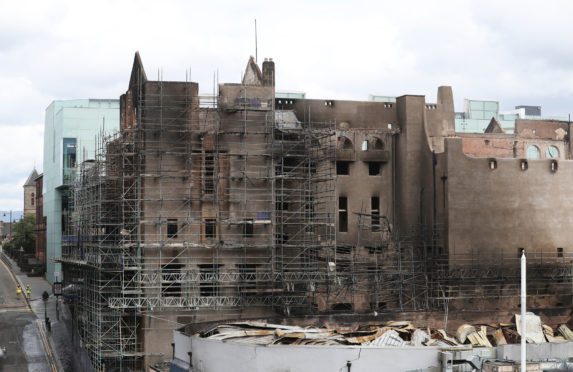
Glasgow School of Art has been criticised for failing to remove potentially lethal asbestos from a building it has spent millions buying and refurbishing.
The 1930s former Stow College building, which has undergone a £16 million refit, has notes taped to walls warning students not to drill or put nails into the walls.
According to papers seen by The Sunday Post, the art school ruled out footing the £1.5m bill to remove galbestos – steel sheeting covered with bitumen-coated asbestos – from the top floor of the building.
Glasgow School of Art considered suing the building’s former owners for not detailing the asbestos in a survey. The 1930s Stow building was bought from Glasgow Kelvin College for £6m in August 2016 to create studio space for students.
A further £16m was spent on refurbishing the building, using money from the Mackintosh Campus Appeal.
A fundraising drive to restore the world-renowned Charles Rennie Mackintosh building after the first fire was launched in 2014, despite the damage being covered by insurance.
Two years later, the fundraising drive was rebranded the Mackintosh Campus Appeal, which included the purchase and conversion of the Stow building.
A senior member of staff said: “You might think due diligence before buying the college would include an asbestos survey. This was not done and it was later discovered that the Stow building interior was riddled with the stuff, and much of the exterior was clad in it.
“What was worse was that the external cladding on the top floor and inside the light wells that penetrate right down through the building are clad in galbestos, a metal profile coated with layers of asphalt and asbestos.
The source said galbestos is flammable and responsible for a fire in the Summerland disaster in the Isle of Man in 1973 when 50 people died.
He said: “After Grenfell, a decision was made to install sprinklers in Stow. We are told that the asbestos walls in the interior have been made safe by coating them with plasterboard and the addition of signs, and the fire risk is managed by the sprinklers. However, the sprinklers point down, and not at the flammable cladding.”
According to board papers, the art school consulted lawyers about asbestos not being detailed in Kelvin College’s management survey.
But the legal advice was they “were offered the opportunity to investigate pre-sale and the onus would be on the buyer to carry out due diligence before entering into a transaction”.
The art school was also warned that “if full litigation is required then the costs could be extremely expensive and could outweigh any benefit that could be gained”.
A fire strategy report said the safety measures taken were “reasonably practicable” and that the “cost, effort and other disadvantages associated with removal/replacement of the cladding would be disproportionate to the risk to life”.
The information is blocked out on the art school’s website but an unredacted version of the board papers has been seen by The Sunday Post.
The Glasgow School of Art said: “Stow College like many hundreds of thousands of buildings constructed in the UK last century involved the use of asbestos in its construction. Most still carry this material in their infrastructure.
“As you would expect, the GSA carried out a full asbestos survey which confirmed areas of known and revealed some previously unidentified areas of asbestos. The GSA informed Glasgow Kelvin College about the latter.
“Encapsulated asbestos when undisturbed and in good condition can remain in place safely if checked regularly as part of a building management programme, which is exactly what is happening in Stow.”

Enjoy the convenience of having The Sunday Post delivered as a digital ePaper straight to your smartphone, tablet or computer.
Subscribe for only £5.49 a month and enjoy all the benefits of the printed paper as a digital replica.
Subscribe